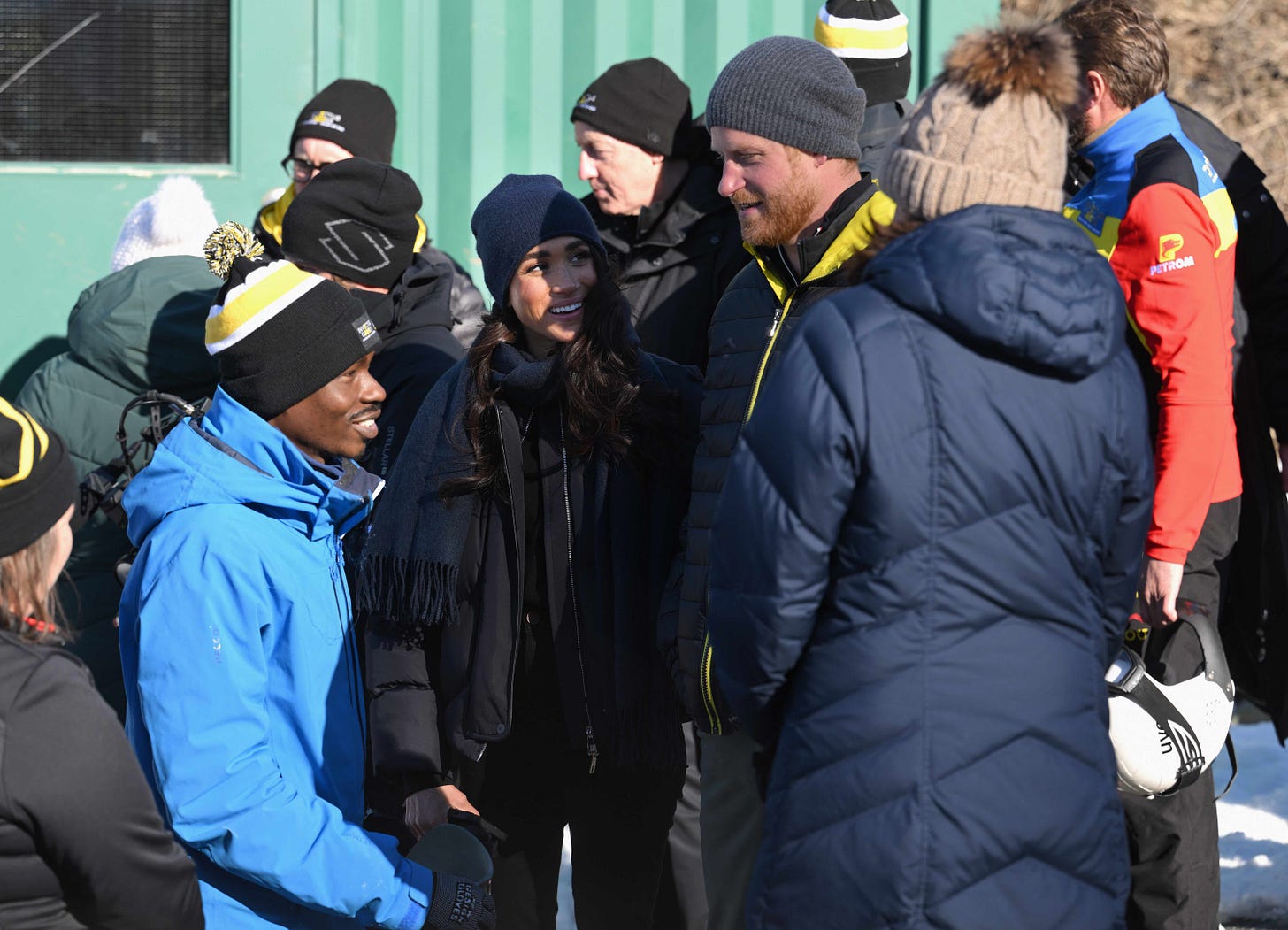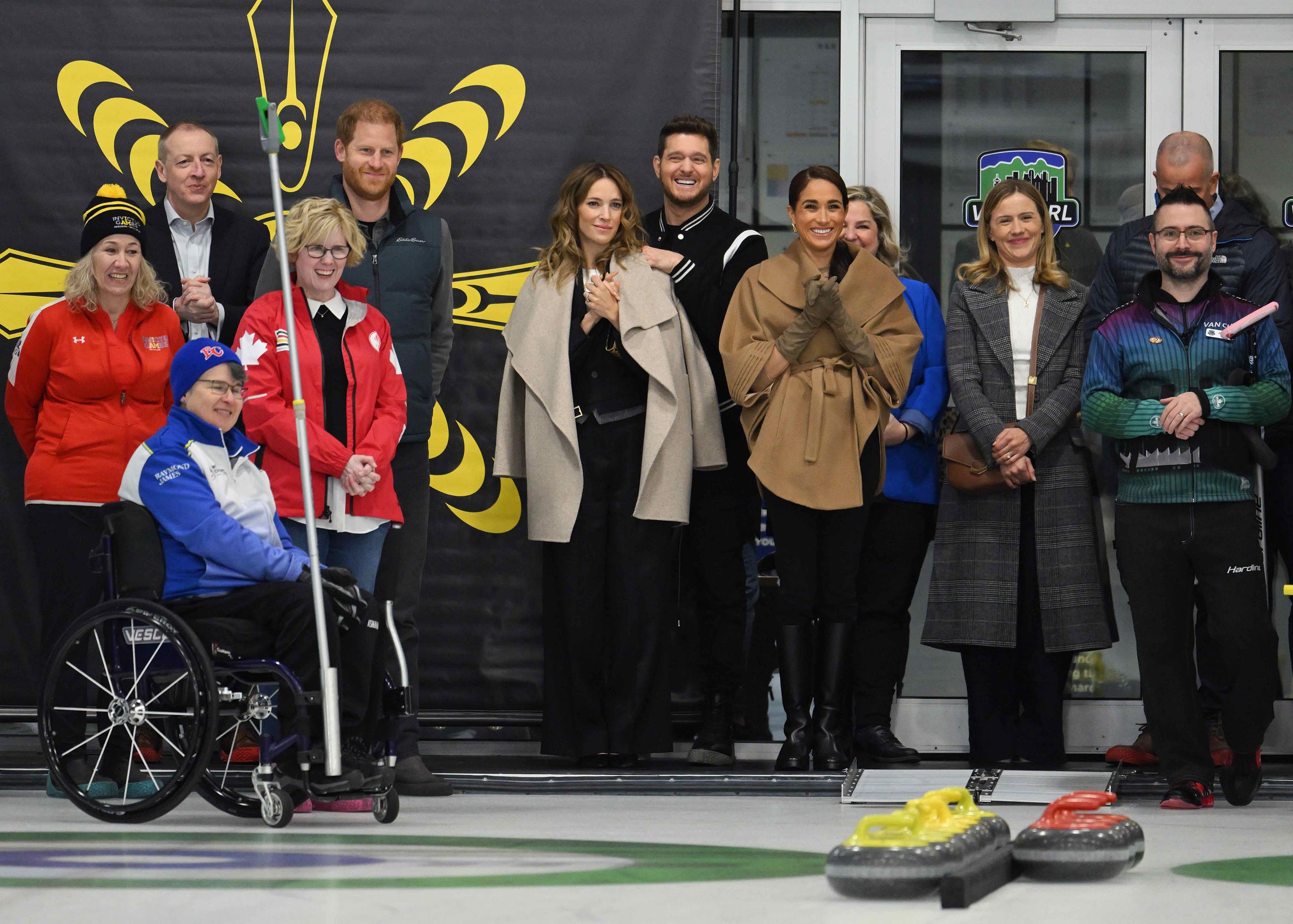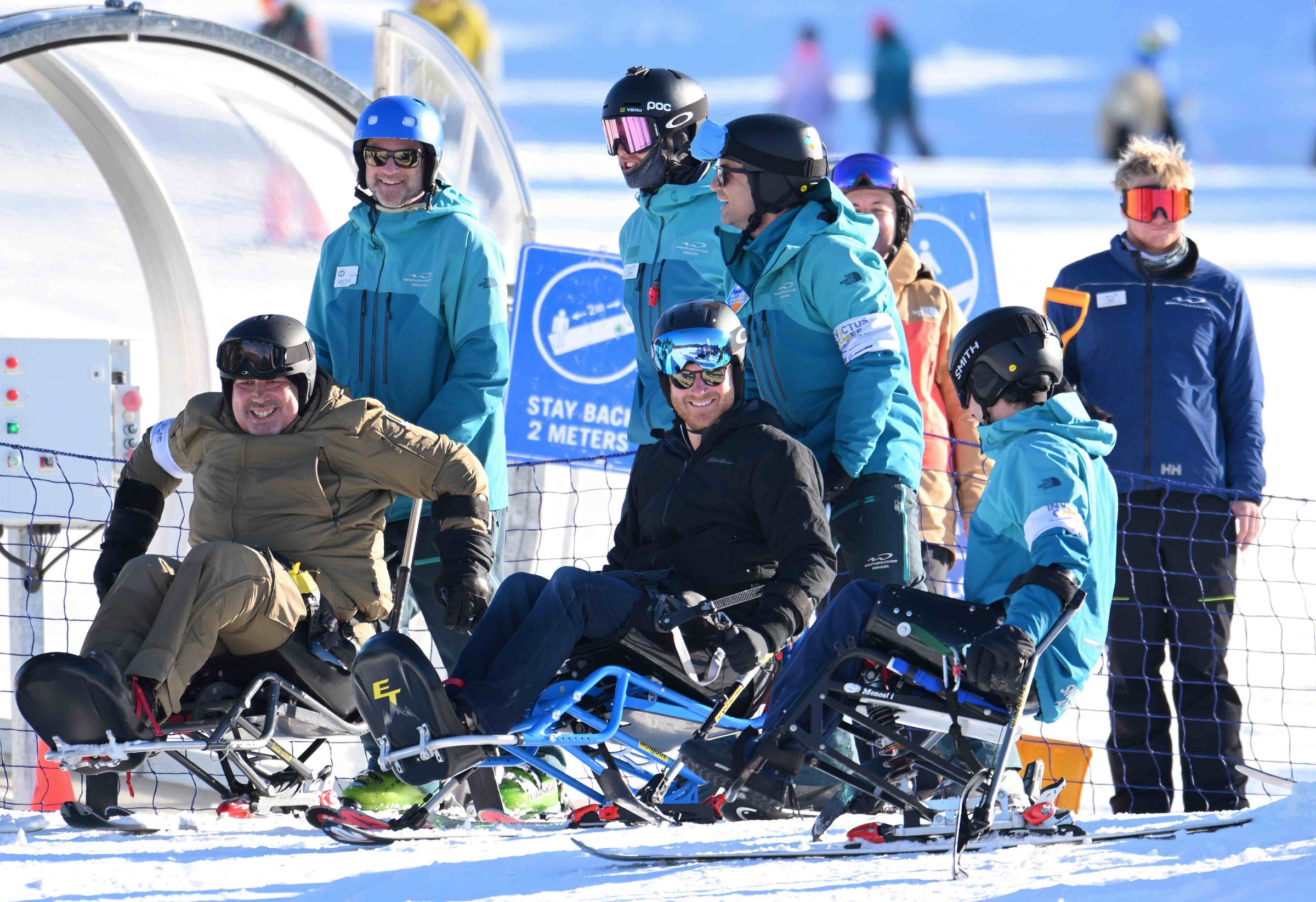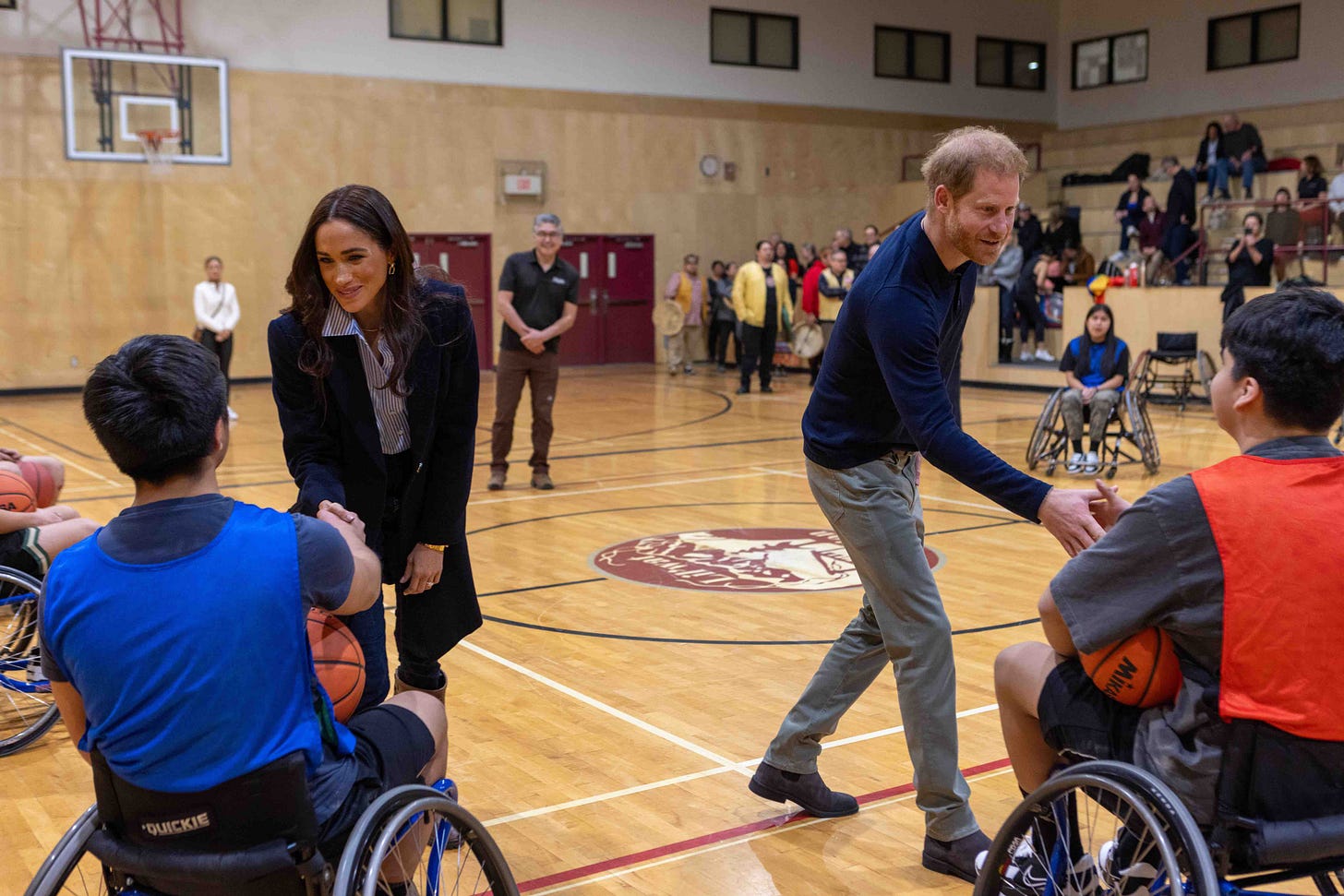Behind the Scenes of Harry and Meghan’s Invictus Trip
Highlights from an unforgettable few days in Canada with the Duke and Duchess of Sussex.
Hello! I am back home after a busy three days with the Duke and Duchess of Sussex in Whistler and Vancouver, Canada. Their trip marked one year until the 2025 Invictus Games, the next installment of the competition Prince Harry founded for wounded, injured, and sick service men and women. For the first time, the games will include adaptive winter events in addition to the usual indoor ones. To prepare the athletes, Invictus organizers held a training camp last week, giving athletes from around the world the chance to try sports including sit ski, skeleton, and curling.
Harry and Meghan joined the sessions each day, spending time with the athletes as well as the organizers and sponsors that make Invictus possible. I was there to watch it all unfold — first on a snowy mountain top, then on the side of an ice track, and finally standing on a curling rink — and heard firsthand what Invictus means to everyone involved.
“These last few days have been very, very special,” the Duke of Sussex said in his remarks at the close of the visit. “Every single one of you inspire me,” he said to the athletes, “every single day.”
Below you will find so many thoughts on the trip, including the remarkable stories of the competitors and the partnership between the Invictus Games and Indigenous communities. Keep scrolling for a behind-the-scenes look on what it was like being part of the press pack, how Harry and Meghan interacted with the media, and what it was like to watch the Sussexes greet the crowds.
My thanks to everyone for following along via my Instagram Stories and — most of all! — to paid subscribers here on Substack. Your support makes it possible for me to take a trip like this.
ICYMI: Have questions about my trip? Head over to this discussion thread, happy to answer whatever I can!
So Many Thoughts on Harry and Meghan’s Invictus Trip

Note: This newsletter is best viewed in your browser — click here to read it there!
What Invictus means to competitors
Since Prince Harry founded Invictus in 2014 — you can read more on that in my primer here — hundreds of injured, wounded, and sick servicemen and women have taken part in each of the games. Vancouver/Whistler will be the seventh installment, following London, Orlando, Toronto, Sydney, The Hague, and Düsseldorf. It is a life-changing experience for those involved, which I got to hear all about from the competitors themselves.
Before the Sussexes came to the training sessions in Whistler, athletes took breaks from learning the new sports to speak to the press. On the first day, we were huddled on the windy mountain top, leaning in to hear these remarkable stories.
“I am continuously recovering from this injury, maybe not physically but emotionally and mentally,” said Ivan Morera, an American who lost his left hand in a combat zone in Afghanistan. “A catastrophic event like that affects you — adaptive sports is my way of dealing with that.” Morera, who won bronze in indoor rowing at the 2023 Invictus Games, hopes to compete next year in skeleton, a head-first, high-speed sled sport, as well as biathlon, which is a combination of cross-country skiing and rifle shooting. “This is my Olympics,” he said. “All those feelings of anger or depression or anxiety or dealing with PTSD, all that comes out while I’m training. I let it out there so I treat my family and friends better.”
At the Whistler Sliding Centre the following day, a few reporters spoke with Peacemaker Azuegbulam, a competitor from Nigeria. In 2020, he had his left leg amputated above the knee after his army unit came under fire. “It was so miserable,” he said. Competing in last year’s Invictus Games helped him see what was possible. “I saw my ability and everyone’s ability and I think about being great in my life,” Azuegbulam shared. Long days training, he added, wore him out in the best way. By the time he got home, “I would be already tired. I don't have any time to worry myself again — instead I got some rest.” He took home gold powerlifting last year, which he said “makes me feel special.”
Later, when speaking at the close of the visit, Harry talked about Azuegbulam’s commitment to training and called him “quite remarkable.”
“The Duke of Sussex gets down on his hands and knees and looks you in the eyes and talks to you… He sees you, he hears you” — Mike Bourgeois, Team Canada
The impact of Harry’s hands-on involvement
“My muscles [are] still hurting,” chuckled Rasmus Penno, a bilateral leg amputee competitor from Estonia, mid-way through the second day of training. Penno first met Harry in 2018 at the Invictus games in Australia. “He has been in Afghanistan and he understands us,” Penno said. “He understands us much better than civilian people.”
Harry took loads of time each day to speak to the competitors on hand, inquiring about their experiences at the training camp. Mike Bourgeois, who has been involved in the Invictus Games since 2020, joined the duke as an ambassador from Team Canada on this trip. On the bus to and from Whistler, Bourgeois shared snippets of the conversations he overheard between the prince and several athletes.
“He wants to know: What is your experience? How is the coaching? How are you learning? How are you being treated?” Bourgeois said. “He wants to get to know the athletes. This is not about him. This is not about any of us, either. It’s about those people he knows are starting their journey of recovery.”
Bourgeois served for 22 years in the Canadian Armed Forces, all while dealing with an undiagnosed spinal cord injury he suffered during his initial training. “In the military, you never want to admit that you are broken or injured. It’s always game-faced, always mission-focused,” he said. Following a heart attack at the age of 48, Bourgeois took up archery, which set him on the path to Invictus.
“You go from struggling in silence — it’s a pride thing,” he said, “to this level of recognition where the Duke of Sussex gets down on his hands and knees and looks you in the eyes and talks to you. It’s like you’re somebody. He sees you, he hears you.”
After spending time with Harry this week, Bourgeois felt the energizing was reciprocal. “This is where the prince gets recharged,” he said. “He’s with his people now. He’s with the soldiers and the veterans and that’s shared experiences. You can just watch him get filled up as the day goes on.”
The partnership between Invictus and the Indigenous communities
All of the literature around the next installment of Invictus prominently acknowledged that the 2025 games are being held on the traditional territories of four nations: the x ʷ məθ kʷə y əm (Musqueam), S ḵwxw ú7mesh (Squamish), St ó:lō and S ə l ílw ətaʔ/Selilwitulh (Tsleil-Waututh) Nations, Skalulmecw L íl wat ̓ Nation and the G élpcal L ílwat Nation.
“An enormous thank you to the four First Nations for allowing us to be on your territory,” Harry said in his remarks on the third day. His gratitude came on the heels of a pair of engagements that show how invested the couple are in partnering with Indigenous communities. On Wednesday evening, the duke and duchess toured the Squamish Lil’wat Cultural Centre. The following morning, they visited the Mount Currie Community Centre on the traditional territory of the Lil’wat Nation. Harry was joined by Chief Dean Nelson for an adaptive basketball game.
Friday’s curling event was opened by remarks from representatives from two of the four nations. “One of the main visions and goals is, for us as a community, to be walking side by side with each and every one of you,” said Chief Wayne Sparrow of Musqueam Indian Band.
“This is what brings us together,” added Councillor Wilson Williams of Squamish Nation. “No matter what classification anyone individually or collectively has, this makes it real. This makes it comfortable. We all belong here…as a leader of our community of Squamish people, I welcome our duke and duchess.”
One more note: The logo for the 2025 Invictus games was designed by four artists, one representing each nation. Indigenous leaders chose the individuals “based on their diverse artistic mediums, including carving and weaving,” according to the release. “The artwork incorporates symbolic elements such as oval shapes, crescents, and trigons, reflecting the spiritual and cultural significance of the Salish art symbols.”

Inside the press pack
When I embarked on this trip, I wasn’t sure what to expect. The strained relationship between the Sussexes and the press has been well documented. Given those tensions, I wondered who would be in the press pack? And what sort of access would we have to the couple?
Keep reading with a 7-day free trial
Subscribe to So Many Thoughts to keep reading this post and get 7 days of free access to the full post archives.







